

Planar Catoms - Carnegie Mellon University. Creating Motion without Moving Parts The self-actuating, cylinder-shaped planar catom tests concepts of motion, power distribution, data transfer and communication that will be eventually incorporated into ensembles of nano-scale robots.
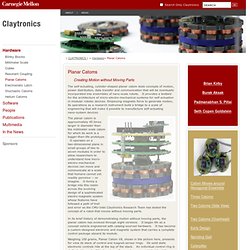
It provides a testbed for the architecture of micro-electro-mechanical systems for self-actuation in modular robotic devices. Employing magnetic force to generate motion, its operations as a research instrument build a bridge to a scale of engineering that will make it possible to manufacture self-actuating nano-system devices.
Swarm intelligence. Swarm intelligence (SI) is the collective behavior of decentralized, self-organized systems, natural or artificial.
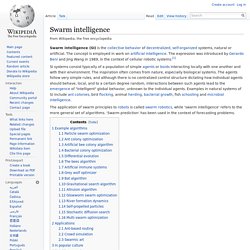
Artificial neural network. An artificial neural network is an interconnected group of nodes, akin to the vast network of neurons in a brain.

Here, each circular node represents an artificial neuron and an arrow represents a connection from the output of one neuron to the input of another. For example, a neural network for handwriting recognition is defined by a set of input neurons which may be activated by the pixels of an input image. After being weighted and transformed by a function (determined by the network's designer), the activations of these neurons are then passed on to other neurons.
This process is repeated until finally, an output neuron is activated. This determines which character was read. Like other machine learning methods - systems that learn from data - neural networks have been used to solve a wide variety of tasks that are hard to solve using ordinary rule-based programming, including computer vision and speech recognition. Background[edit] History[edit] Farley and Wesley A. Models[edit] or both. Lotus effect. Water on the surface of a lotus leaf.

Water droplets on taro leaf with lotus effect (upper), and taro leaf surface magnified (0–1 is one millimetre span) showing a number of small protrusions (lower). Computer graphic of a lotus leaf surface. A water drop on a lotus surface showing contact angles of approximately 147°. The lotus effect refers to the very high water repellence (superhydrophobicity) resulting in self-cleaning properties, as exhibited by the leaves of the lotus flower (Nelumbo).[1] Dirt particles are picked up by water droplets due to a complex micro- and nanoscopic architecture on the surface, which minimizes the droplet's adhesion to said surface. Superhydrophobic and self-cleaning properties can also easily be demonstrated in many other plants, for example Tropaeolum (nasturtium), Opuntia (prickly pear), Alchemilla, cane, and on the wings of certain insects.
Functional principle[edit] Kevin Warwick. Kevin Warwick (born 9 February 1954) is a British engineer and professor of cybernetics at the University of Reading in the United Kingdom.
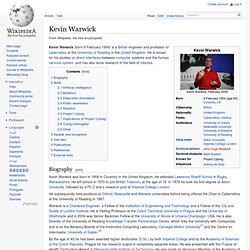
He is known for his studies on direct interfaces between computer systems and the human nervous system, and has also done research in the field of robotics. Biography[edit] Kevin Warwick was born in 1954 in Coventry in the United Kingdom. He attended Lawrence Sheriff School in Rugby, Warwickshire. He left school in 1970 to join British Telecom, at the age of 16. The Biomimicry Manual. Miura fold. Crease pattern for a Miura fold.
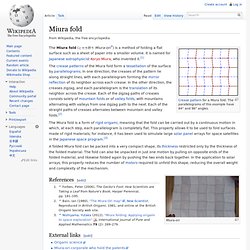
The parallelograms of this example have 84° and 96° angles. The Miura fold (ミウラ折り, Miura-ori?) Is a method of folding a flat surface such as a sheet of paper into a smaller volume. It is named for Japanese astrophysicist Koryo Miura, who invented it.[1] The Miura fold is a form of rigid origami, meaning that the fold can be carried out by a continuous motion in which, at each step, each parallelogram is completely flat. A folded Miura fold can be packed into a very compact shape, its thickness restricted only by the thickness of the folded material. Miura-ori References[edit] Jump up ^ Forbes, Peter (2006), The Gecko's Foot: How Scientists are Taking a Leaf from Nature's Book, Harper Perennial, pp. 181–195 .Jump up ^ Bain, Ian (1980), "The Miura-Ori map", New Scientist . External links[edit]
Intelligent Clothing Inspired By Pine Cones. A new type of 'smart' clothing which adapts to changing temperatures to keep the wearer comfortable is being developed by two universities using nature as a guide.
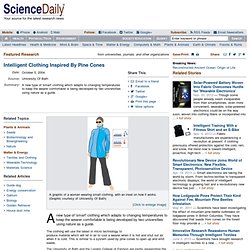
The clothing will use the latest in micro technology to produce material which will let in air to cool a wearer when it is hot and shut out air when it is cold. This is similar to a system used by pine cones to open up and emit seeds. The University of Bath and the London College of Fashion are jointly researching the material, which they think could be in everyday use by people within a few years. The project has been chosen as one of eight to represent UK science at the Expo 2005 in Japan from March to September next year, whose theme is Nature's Wisdom. The Expo is expected to attract 15 million visitors, and other UK science projects will be the Eden Project and the Millennium Seed Bank at Kew. "We've all known days when the weather alters quickly and it's difficult to dress to match the changing temperature.
Notes: 1. 2. Conifer cone. The male cone (microstrobilus or pollen cone) is structurally similar across all conifers, differing only in small ways (mostly in scale arrangement) from species to species.

Extending out from a central axis are microsporophylls (modified leaves). Under each microsporophyll is one or several microsporangia (pollen sacs). The female cone (megastrobilus, seed cone, or ovulate cone) contains ovules which, when fertilized by pollen, become seeds. Bionics. Bionics (also known as bionical creativity engineering) is the application of biological methods and systems found in nature to the study and design of engineering systems and modern technology.

[citation needed] The transfer of technology between lifeforms and manufactures is, according to proponents of bionic technology, desirable because evolutionary pressure typically forces living organisms, including fauna and flora, to become highly optimized and efficient. Biomimicry. Biomimicry or biomimetics is the imitation of the models, systems, and elements of nature for the purpose of solving complex human problems.[1] The terms biomimicry and biomimetics come from the Greek words bios, meaning life, and mimesis, meaning to imitate.
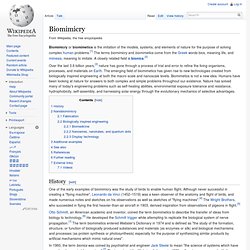
A closely related field is bionics.[2] Over the last 3.6 billion years,[3] nature has gone through a process of trial and error to refine the living organisms, processes, and materials on Earth.